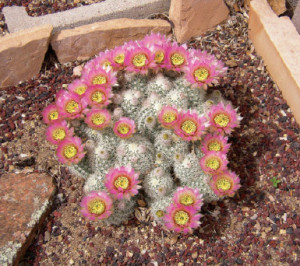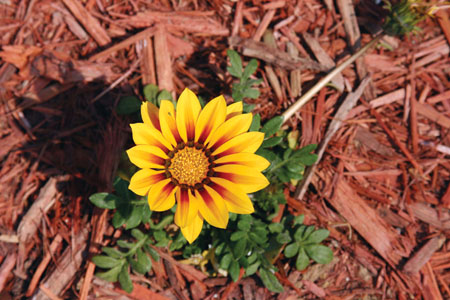Dandies of the Desert
04 Jul 2009
Many agaves, yuccas and other succulents perfectly partner with our semiarid climate and cold winters.
They also add sculptural interest and thrive in the garden’s hottest spots. Here’s a brief guide to some of the more fascinating specimens.
For Front Range residents, the word “succulent” most likely conjures up visions of prickly pears, which lurk throughout the native prairie and in more adventurous gardens. “Yucca” invariably brings to mind our ubiquitous native, Yucca glauca, which farmers curse and homeowners shun (it is so prickly, after all). Yet a dramatic suite of cousins to our local yucca has recently cropped up at garden centers. These “woody lilies,” as yuccas and other woody succulents in the lily family are sometimes called, generally grow wild in the high mountains of Texas, Arizona and New Mexico. Despite their southerly origins, they have an amazing tolerance for our cold temperatures. In the past decade, we planted dozens of succulents at Denver Botanic Gardens and were stunned by how vigorously they grew and how little damage the longest, coldest winters inflicted on them. These weren’t relegated to the rogue cactus garden, either. In fact, these plants combine particularly well with our tremendous palette of native xeriscape perennials, including penstemon, agastache, salvia and such. They also provide drama in dreadfully sunny spots, where other plants often refuse to grow. Not your typical perennials, yuccas, agaves and their succulent cousins have sculptural forms that approach the size of giant shrubs—even trees—when mature. Although you may not be able to afford a giant specimen (they’re quite costly), young plants establish quickly and grow surprisingly fast. Just site them where their mature magnificence will not be stunted by neighboring plants or hampered by encroaching trees. Another planting approach is to group succulents. Particularly dramatic groupings combine the sprawling, rounded shapes of prickly pears with the more structural forms of agaves, yuccas and their cousins. This incredibly evocative tableau recalls the great Southwestern deserts where these plants originate. And every true-blue Coloradan knows that desert plants are more at home on the Front Range than the eastern hardwoods and bluegrass that have long—and boringly—dominated local gardens.
If you’re prepared to take the “prickly plunge” in your garden, you’ll discover that few plants provide the visual punch of woody lilies and other succulents. These exclamation-point plants elevate and ennoble the gardens they grace. But place them carefully, with an eye toward the future. These are plants to grow old with. When they bloom, their majesty will win over even the most ardent anti-prickly gardener.
Here are some succulents that grow splendidly here:
Another planting approach is to group succulents. Particularly dramatic groupings combine the sprawling, rounded shapes of prickly pears with the more structural forms of agaves, yuccas and their cousins. This incredibly evocative tableau recalls the great Southwestern deserts where these plants originate. And every true-blue Coloradan knows that desert plants are more at home on the Front Range than the eastern hardwoods and bluegrass that have long—and boringly—dominated local gardens.
If you’re prepared to take the “prickly plunge” in your garden, you’ll discover that few plants provide the visual punch of woody lilies and other succulents. These exclamation-point plants elevate and ennoble the gardens they grace. But place them carefully, with an eye toward the future. These are plants to grow old with. When they bloom, their majesty will win over even the most ardent anti-prickly gardener.
Here are some succulents that grow splendidly here:
1. Multiple-Headed Giant
Possibly the easiest of the giant yuccas to find at nurseries, Yucca thompsoniana, or Thompson’s yucca, is also the most versatile and adaptable. This rugged giant grows more than 15 feet tall in nature, with flowering stems that rise another 5 feet. Unlike the closely related Y. rostrata or Y. elata, this species invariably produces multiple heads, and branches as it matures. Y. thompsoniana’s leaves have a distinct yellow cast, while the foliage of its closest relatives is much more silvery or whitish. Y. thompsoniana’s leaves also lack as many filaments and are generally not as long, usually less than 15 inches, and held more rigidly. Thompson’s yucca produces spire-like flowers in late May and June, each giant head creating its own gleaming candelabra of ivory bells. The floral display lasts several weeks and the flowering stems are not altogether unsightly. But the plant rarely produces decorative seedpods, because the native pronuba moth seems unable to pollinate it in our climate. This possibly helps the plant remain vigorous, so that it blooms reliably every year. Originally from the Big Bend in Texas, Y. thompsoniana is incredibly durable on the Front Range. Along with fellow yuccas, it needs a somewhat protected spot in Colorado’s Zone 5 urban belt, so don’t plant it above elevations of 6,000 feet.2. Big Beauty
Yucca faxoniana is, quite simply, gigantic. Think “palm tree”—which is the general look and feel of this yucca. Each leaf can be 5 inches wide and greater than 5 feet in length, so planting it in a small garden would be challenging. Y. faxoniana is a high-elevation plant that thrives in a wide variety of sites and soils along the Front Range. But a maximum of sun and heat is needed to ripen new growth and to ensure your investment. Although yuccas are obviously drought tolerant, regular watering during dry spells keeps them vigorous and makes them better bloomers. Y. faxoniana’s remarkable ivory flowers are well worth the effort, although this species doesn’t bloom as reliably as most other yuccas.3. Tough Stuff
Unquestionably the toughest of the giant yuccas, Yucca elata—the New Mexico state flower—attains amazing stature in Colorado. I know of a plant in Pueblo that could easily hide a Volkswagen, and I mean a minivan, not a bug. Y.?elata produces dozens of breathtaking, towering candelabras, with some approaching 20 feet at the tips. A dramatic planting grows on 6th Avenue near the I-25 interchange. It’s been there half a century and still reliably blooms each year. One caveat: This plant can sucker substantially in sandy soils. I’ve been trying to remove the vigorous growth from one specimen for years, some of which spread 8 feet from the parent trunk.4. Flower Fiend
Yucca rostrata is an uncommon yucca that only grows in a very small area in Texas, but is more common in Mexico. A few botanists lump Y. rostrata with Y. thompsoniana, but the two are so distinctive that both deserve a place in the garden. Y. rostrata has substantially longer, more lax leaves. These form the most amazing sphere of silvery white foliage that can be a stunning focal point in either formal or naturalistic gardens. Y. rostrata is also less prone to branching than Y. thompsoniana, which has yellow-tinged, more rigid foliage and a laxer trunk growth. As if Y. rostrata’s massive trunk and beautiful foliage aren’t enough, its flower head is especially ample and brilliant white. A Phoenix wholesale nursery planted vast numbers of this rare yucca in its growing fields years ago, where they’re attaining dramatic height and form, and a symmetry that wild-collected plants never would have. It’s now marketing these divine plants throughout America at quite reasonable prices for such a rare, slow-growing plant. My advice: Examine your landscape to find a perfect spot to plant one of these perfect yuccas.5. High-Mountain Hardy
In my experience, Agave neomexicana is unquestionably the hardiest agave, especially if you obtain one grown from seed collected in the White Mountains of New Mexico, or from Cooke Peak in New Mexico’s Luna County. These forms, which grow at elevations above 6,000 feet, rarely experience winter damage, even in the coldest Front Range winters. They also grow successfully in large outdoor containers. Few plants provide the structural drama of mature agaves, but handle these plants carefully—their spines are sharp, and potentially deadly. Still, a well-grown agave rosette is so elegant and sculptural that I wouldn’t want to be without one in the garden. I particularly love the look of agaves nestling in snow. A. neomexicana blooms for much of the summer and Bullock’s orioles love to feed on the plant’s rich nectar.6. Lofty Lovely
Often said to be the hardiest of the agaves, Agave parryi grows at lofty elevations on the Mogollon Rim near Flagstaff, Ariz., where I once found it among lingering snowbanks in May. It’s best to give this plant a protected sunny site, however, because cold Colorado winters can mar the rosette tips, which are quite breathtaking. Like a few other agaves, this plant sends out runners that can appear up to 8 feet or farther from the parent plant. Friends are usually anxious to take them off my hands, but eventually, I’ll have to leave a few because the parent rosette dies when it finally blooms. Although this species is called a century plant, it takes only a decade or two to reach blooming size.7. Rare Find
Agave havardiana is rarer than the other agaves I’ve mentioned here, but it’s worth seeking out because of its distinct beauty. The rosette is slightly more relaxed than other agaves, and it can grow to nearly 4 feet across. The truly massive inflorescence features waxy, golden flowers tinged with orange—a magnet for birds and insects of all kinds.8. Go Bananas!
Yucca baccata has giant fruits that look a bit like bananas when ripe, and often turn a lovely yellow color as well. They also taste a bit like bananas, as I discovered when I peeled a pod and sampled the flesh. Our native subspecies grows in both southwestern Colorado and the Sangre de Cristo foothills, often at surprisingly high elevations. The leaves, which are several inches wide and more than a yard long, create a substantial focal point in the garden. My favorite feature is the way the leaf margins peel off along the edges to create curly strings that look like lace from a distance. A sizable plant, the banana yucca, as Y. baccata is commonly called, can grow up to 4 feet tall and much wider. It thrives in a variety of sites and soils, and is a superb selection for gardens at elevations up to 7,000 feet.9. Rosy Red
Hesperaloe parviflora is the least expensive and most indispensible woody lily. Its dark, blue-green foliage is a great foil to other succulents, and its delicate, rosy red flowers last all summer. It’s also a very hardy plant. Who could ask for more?10. Silver Spoon
Dasylirion texanum is a grassy-looking cousin of agaves and yuccas. Commonly called a Texas sotol or desert spoon, this rosetted woody lily is abundant in south central Texas and Mexico. Several of the more common silver and blue species, like D. wrightii, are generally not as hardy, but D. texanum fares well in our winters. Unlike other sotols, which can take decades to bloom, the Texas sotol grows fast and blooms only a few years after planting. D. texanum’s flower stems tend to be less than 10 feet tall, but they’re very showy, forming dense, club-like clusters of creamy flowers that turn into decorative masses of persistent, tan-colored seeds. Texas sotol is not quite as stiff and sharp as its more sadistic silvery cousins, but it’s famous for producing spines that point in several directions to snag you coming and going. The innocent-looking clumps can inflict nasty cuts, so handle this plant with care—and heavy gloves. These and many other succulents dazzle and delight us with their flowers and interesting shapes. Luckily, they’re becoming more attainable at local nurseries, and nearly every Front Range garden has a hot spot where these unique plants will flourish.
Panayoti Kelaidis is director of outreach at Denver Botanic Gardens and a frequent contributor to Boulder County Home & Garden Magazine.
These and many other succulents dazzle and delight us with their flowers and interesting shapes. Luckily, they’re becoming more attainable at local nurseries, and nearly every Front Range garden has a hot spot where these unique plants will flourish.
Panayoti Kelaidis is director of outreach at Denver Botanic Gardens and a frequent contributor to Boulder County Home & Garden Magazine. 











